 |
|

|
 |
TABLE of CONTENTS
 |
Anchors aweigh: 2021 shipping season unofficially opens with first vessel passage on Mississippi River |
By Joseph Palmersheim
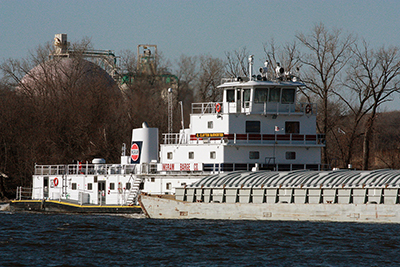
The motor vessel R. Clayton McWhorter was the first tow of the season for the second consecutive year, locking through Lock 2 in Hastings at about 9 p.m. Friday, March 19, reaching its destination at the Red Rock Terminal in St. Paul on Saturday morning. It was carrying barges loaded with cement. The photo was taken just south of Interstate 494 near Wakota Bridge. Photo by Patrick Phenow |
It started with a rumble and propeller surge kicked up from the 6,120 horsepower engines of the R. Clayton McWhorter, a 120-foot vessel pushing barges of cement on the Mississippi River from Hastings to St. Paul March 19-20.
The 46-year-old vessel’s trip marks the unofficial start of the 2021 shipping season. It’s the first load of what could, if past seasons are an indication, be more than 14 million tons of cargo moved on Minnesota rivers this year. The major river ports are in St. Paul, Savage, Red Wing and Winona.
When totals from Minnesota’s Lake Superior ports (Duluth-Superior, Two Harbors and Silver Bay) are added, more than 70 million tons of cargo could end up passing through Minnesota ports this year.
“River ports are a vital link in Minnesota's multimodal network, responsible for getting more of Minnesota’s grain to world markets than any other mode, along with a number of other bulk commodities,” said Patrick Phenow, Ports and Waterways program manager, Office of Freight and Commercial Vehicle Operations. “It’s also how we get several important bulk products into Minnesota, such as fertilizer for the state’s grain producers, cement for road construction and road salt for getting us through Minnesota winters.”
In addition to ships and cargo, grant funding is flowing to some of Minnesota’s ports this year, too.
Four port development projects will receive grants totaling $14 million to support freight movement on Minnesota’s waterways. This funding comes from MnDOT’s Port Development Assistance Program and will help one project in the Twin Cities metro area and three projects in Greater Minnesota improve the statewide freight transportation system that supports growing industry and business.
“The PDAP program is incredibly important for maintaining, improving and expanding infrastructure at Minnesota’s public ports,” Phenow said. “For the smaller ports, these funds are necessary for almost all of their major rehabilitation projects. For all of the public ports, these funds help keep them a competitive mode to use by maintaining a state of good repair and expanding operations as those opportunities arise.”
The Minnesota PDAP funding combines with federal, local and private funding for a total ports construction program of $26.7 million.
The four projects receiving PDAP funding are:
Twin Cities area:
- St. Paul Port Authority ($6.3 million PDAP funding) – Replace 1,460 feet of dock wall at St. Paul’s Barge Terminal Two with a new sheet pile dock wall supported by a new tieback system. Total project cost is $8.1 million.
Greater Minnesota:
- Duluth Seaway Port Authority ($5 million PDAP funding) – Repair and rebuild 1,175 feet of failing dock wall on Berth 11 at the Clure Public Marine Terminal in Duluth. Total project cost is $10.5 million.
- Duluth Seaway Port Authority ($2.4 million PDAP funding) – Build 112,500-square-foot fabric warehouse with three concrete truck bays and three 10-foot by 10-foot garage doors, and an asphalt building foundation. Total project cost is $5.3 million.
- Wabasha Port Authority ($300,000 PDAP funding) – Build a new Mississippi River barge terminal with access road, sheet pile dock face, steel pile pipe clusters, truck scale and field office. Total project cost is $2.8 million.
Learn more about the selected projects and the PDAP program.
The 2020 river shipping season opened April 6 and concluded Nov. 30.
“The average start date for the river shipping season is March 18, making this year almost exactly average,” Phenow said. “Early signs point to this likely being a good year for river shipping in terms of weather and flood forecasts.”
|  |
|

|
 |
TABLE of CONTENTS
 |
Teleworking, one year on: "I am looking forward to 'normal' again" |
By Joseph Palmersheim

Lois Butcher, a financial services specialist based at Central Office, made her “crazy hat” last year when she thought people could use a laugh during Skype meetings. Now, a year into teleworking, her camera isn’t used as much anymore, and neither is the hat, she said. Submitted photo |
When work turned upside down last year, Lois Butcher responded by bringing a little levity to the situation: she became known for wearing a “crazy hat” during virtual coffee breaks via Zoom.
A year on, the coffee break group has dwindled and she rarely turns on her camera anymore, she said. No camera, no need for the hat, she said.
Butcher, a financial services specialist based at Central Office with Office of Research & Innovation, continues to telework, but misses the interaction with her co-workers. She’s also tried to make the best of a home office, like the 30 percent of MnDOT workers who have continued to telework (down from around 50 percent in spring 2020).
“I learned some things about my home office, such as discovering that my basement is really cold in the winter,” she said. “I have crocheted fingerless gloves and old-school leg warmers to cut the chill. I decorated my office area a little more with some knick-knacks and lights just to make it a little more inviting.”
She’s been to Central Office a few times, noting that it’s “a very lonely place now.” Saving up vacation time has been an unexpected plus.
“I am looking forward to normal again,” Butcher said. “Even though we have had our virtual coffee breaks, I miss seeing my co-workers. I wonder how things will change, as I am sure they will going forward.”
Many MnDOT employees have been in the same position since March 2020, when agency staff left an office-based setting on a Friday afternoon. Some haven’t been back since due to the pandemic.
Being able to quickly pivot from an office-centric work environment to a digital one for so many people at once was the result of pandemic planning from Emergency Management, said Bob Bennett, business applications manager, MNIT.
“We were far more prepared for this than many organizations,” he said. “Most of the major changes needed were known and on the plan – we just needed to execute them. We still had some challenges but we weren’t starting from zero.”
The initial wave of telework onboarding ended in April 2020. MNIT staff worked hard to ensure changes had minimize impact, Bennett said, while facing challenges like sending updates to laptops that are on home Internet connections. This takes more time, planning and follow-up than when employees are on fast on-site networks, he said.
As a result, MnDOT is “more prepared for massive disruption than ever.”
“Not only are MnDOT staff more mobile and practiced at working remotely, but we have the support processes and services better tuned for a remote workforce,” Bennett said. “MNIT staff were able to transition themselves to working remotely very smoothly and that enabled them to really focus on keeping MnDOT running. A lot of people put in many long days getting through the initial wave. We have a deep appreciation for the support MnDOT has given us, from pandemic planning to resourcing/accommodating changes needed.”
Looking to the future, MnDOT is awaiting further guidance from MMB on protocols for bringing staff who have been teleworking back to their offices. That guidance could come as soon as April 1; however, the expectation remains that those who can telework should plan to continue to do so through June. The exact timeline will be dependent on several factors, including the state’s progress on vaccinations. Agency leaders anticipate using a phased approach to bringing people back, so employees will not all return at the same time. |
 |
|

|
 |
TABLE of CONTENTS
 |
New game-based educational tool explains benefit cost, lifecycle cost analysis |
By Joseph Palmersheim
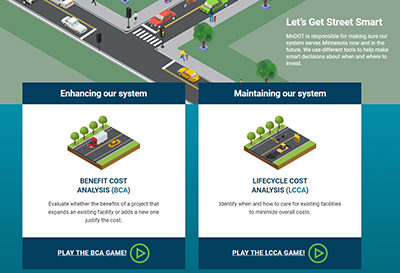
MnDOTís new online resource describing benefit cost analysis and lifecycle cost analysis is set up like a game, with participants being able to choose which options they think would work best on two projects. |
“Do the benefits of that project justify the cost?”
“Why are we doing construction on a road that seems to be in fine condition?”
“Does a quick repair or a major construction project make more sense at this time?”
In order to answer questions like these, MnDOT developed a new resource describing benefit cost analysis and lifecycle cost analysis, two of the tools transportation agencies use to make decisions about where and when to invest.
Here’s the twist: the resource is set up like a game.
“We wanted this to be engaging and adding some game-like elements helps to put people in our shoes of considering different factors when making decisions,” said Philip Schaffner, director of Statewide Planning, Office of Transportation System Management.
The Spending Minnesota Transportation Money Wisely website allows users to redesign an intersection to see how the benefits and costs compare in two different contexts. The site, developed in conjunction with HDR, took about a year to build.
Comparing different strategies for maintaining a road allows employees to consider the tradeoffs between short-term costs and long-term costs – and what leads to the lowest cost overall, Schaffner said.
“The primary audience is really the public, but I hope employees will understand the basic ideas of benefit cost analysis, life cycle cost analysis and the types of decisions they inform,” Schaffner said.
|
| |
|

|
 |
TABLE of CONTENTS
 |
MnDOT adopts Sustainable Transportation Advisory Council recommendations |
By Joseph Palmersheim
MnDOT recently adopted a series of recommendations proposed by the Sustainable Transportation Advisory Council to help the agency reduce carbon pollution from transportation.
The recommendations and agency responses outlined in the report focus on creating measurable strategies to help the state transition to a low-carbon transportation system that maximizes the health of people, the environment and the economy. This includes:
- Developing a clean fuels policy
- Supporting electric vehicle rebates
- Increasing investment in charging infrastructure
- Setting a preliminary goal of a 20 percent reduction in vehicle miles traveled statewide by 2050
- Prioritizing transit and high-occupancy vehicles on MnDOT-owned right of way
- Continuing to prioritize other solutions before considering highway expansion
“Gov. Walz has prioritized climate action, and collaborating with Minnesota leaders through the STAC process is one way that MnDOT is working to lead in this area,” said Tim Sexton, assistant commissioner, Sustainability and Public Health. “The STAC is an ongoing process and the agency welcomes comments and feedback on the process as we work together to address the climate crisis.”
MnDOT created the STAC in the wake of the agency’s 2019 Pathways to Decarbonizing Transportation report. The report identified several actions, recommendations and opportunities to reduce greenhouse gas emissions from surface transportation.
STAC serves as a form of long-term public engagement that includes leaders from the public, private and nonprofit sector, cities, counties and community groups. STAC co-chairs are Commissioner Margaret Anderson Kelliher and Chris Clark, president of Xcel Energy for Minnesota, North Dakota and South Dakota. The goal of the STAC is to make recommendations to the agency to help Minnesota move to a low-carbon transportation system of the future that aligns with the states climate goals, with a focus on economic development and equity.
“We are deeply grateful to the members of the STAC for their thorough recommendations as we work collaboratively to reduce carbon pollution from the transportation sector,” Anderson Kelliher said. “Our climate is changing, and we all share in the responsibility of working harder to achieve Minnesota’s Next Generation Energy Act emission reduction goals. The recommendations of the STAC will be critical to our success.”
| |

|
 |
TABLE of CONTENTS
 |
Finance staff develops new online payment system |
By Shannon Fiecke, Office of Research & Innovation
Perhaps it’s a variation of the old “if a tree falls” riddle: If a check arrives and there are no employees there to process it, does it make a payment?
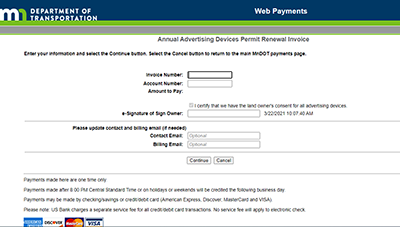
Companies can now renew billboard advertising permits online thanks to a new system developed by the Office of Finance in collaboration with MNIT and U.S. Bank. Submitted photo |
Thanks to a new online payment system, this predicament has been solved.
When Office of Finance staff were sent home a year ago, figuring out how to handle more than a thousand billboard advertising permit renewals was very much on their mind.
Invoices for these renewals, due to arrive at the Office of Land Management by July 1, had to be sent by late May. At the time, few of MnDOT’s offices, which don’t use SWIFT (the agency’s main accounting and procurement system), could accept online payments.
“We knew we would be flooded with checks,” said Anne Gladhill, accounting director.
While a plan had been in the works to set up an agency-wide electronic payment system, the need was now immediate. Enlisting an experienced online web developer from the Department of Human Services, the agency’s cash and collections unit worked with MNIT and U.S. Bank to develop a system to accept electronic payments, starting with the highway advertising permits for the Office of Land Management.
The initial system was introduced within two months, with the first module launching in May 2020. The second module took four months due to increased complexity.
Now, MnDOT accepts all major credit and debit cards in addition to e-checks. Customers can access the online payment system anytime, and in addition to the customer service benefits, the new system eliminates the processing time for MnDOT staff. Under the old system, a physical check had to be handled and processed by several people.
A module has been added for SWIFT invoices in recent months, including an option for damage restitution, whose team was getting numerous requests for an electronic payment option.
“Our online payment site is now utilized daily, and the usage of our site continues to grow each month,” Gladhill said.
An online training registration, certification and payment module for MnDOT is being explored as a third phase project, which may affect multiple offices across the agency.
The Office of Research & Innovation compiled an Innovations During COVID-19, highlighting the online payment system and other staff innovations. Some projects received mentions in the Governor’s Blue Ribbon Council on Information Technology’s February 2021 Report. |
| |
|

|
 |
TABLE of CONTENTS
 |
New social media policy aims for guidance, clarity |
MnDOT’s new Social Media Use Policy went into effect March 25. This new policy serves several purposes:
- Outlining how the agency uses its official social media accounts, including enforcement of Social Media Community Rules for people who comment or interact with MnDOT pages/accounts
- Providing general guidance for employees about personal social media use, including awareness that personal social media use may become the basis for discipline
- Providing clarity for employees on how the Offices of Human Resources and Equity and Diversity will investigate claims or reports of questionable use
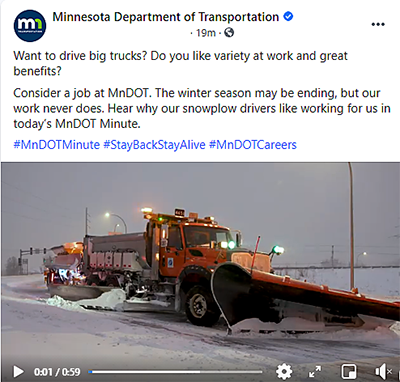
MnDOT has social media accounts on several apps including FaceBook. |
Nothing in this policy prohibits or infringes on speech or expression protected by law, including employees’ First Amendment rights, according to Jake Loesch, director, Office of Communications and Public Engagement. Loesch added that MnDOT does not actively monitor employees’ personal social media usage, and the policy is meant to provide information and clarity to employees – not to encourage or discourage social media use or control what employees can or cannot say.
“It is important to remember that we are all ambassadors for MnDOT and must maintain a high standard of professionalism and conduct,” he said. “Even if you don’t identify yourself as a MnDOT employee on social media, our personal behaviors can reflect on our agency and the State of Minnesota enterprise. We simply ask that you keep that in mind when using personal social media accounts.”
The Office of Communications and Public Engagement developed the policy in close consultation with the offices of Human Resources and Labor Relations, Equity and Diversity, and Chief Counsel. MnDOT will review the policy annually, instead of the standard two-year review timeline.
Lunch-and-learn sessions will be scheduled soon to provide information about the Social Media Use Policy and answer any other questions employees may have. In addition, information about the policy will be incorporated into “Respect in the Workplace” classes and the Social Media at Work e-Learning lesson. |
| |
|

|
 |
TABLE of CONTENTS
 |
Latino ERG outreach project asks students to depict transportation |
By Joseph Palmersheim
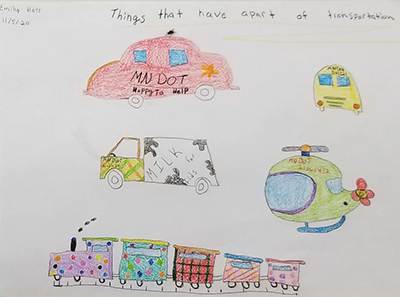
These are some of the responses the Latino Employee Resource Group received when they asked Minnesota students what they think of when they hear the word transportation. |
Emily thought of “car, truck, bus or train.”
Nayra thought of those, too, and added “taxis, busways and airplanes.”
Finally, Brianna drew a cat driving a train.
MnDOT’s Latino Employee Resource Group community outreach project recently asked Minnesota students what they think of when they hear the word “transportation.”
The “Transportation Drawing and Writing Challenge” collaborated with 20 students from The Art and Science Academy, Isanti; and Academia Cesar Chavez Charter School, St. Paul.
“The LAERG Community Outreach Committee brainstormed ways we could reach out to grade school students during COVID,” said Lena Garcia, LAERG member. “We wanted to be able to help the schools, parents and children with school supplies and an activity.”
Each participating student received a STEM activity. These sets, purchased by the LAERG for school outreach activities, contained a variety of writing and drawing tools.
Students spent 30-60 minutes to draw a picture or write a story, Garcia said. Marcia Lochner, STEM Education and Outreach program manager, judged the entries on organization, subject matter and creativity.
Two students from each school won recognition awards. These awards included a STEM activity kit and a signed certificate from Commissioner Margaret Anderson Kelliher.
“We were very happy with the interest and response from this alternative event,” Garcia said.
The LAERG Community Outreach subcommittee plans to revisit annual in-person participation at St. Paul’s Cinco de Mayo celebration in May, and at the Fiesta Latina this fall.
The LAERG meets monthly. Interested employees may contact Christian Guerro, committee chair, or Isela Gomez, co-chair, for meeting information. |
| |
|

|
 |
TABLE of CONTENTS
 |
On the Job: Michael Johnson plans for future of flight |
By Joseph Palmersheim
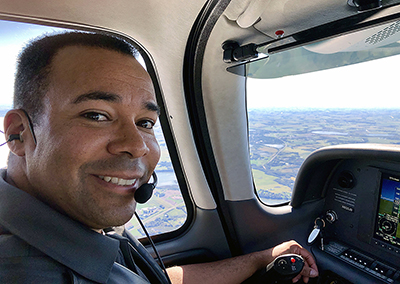
Michael Johnson is on a mobility assignment with the Office of Aeronautics as an Unmanned Aircraft Systems program planner. Submitted photo |
Michael Johnson, Unmanned Aircraft Systems program planner, has been with MnDOT for 10 years. His current role closely aligns with his personal interests in aviation, “so the day-to-day work and related conversations are a lot of fun.”
What do you do in your current role?
I am currently on a mobility assignment with the Office of Aeronautics, developing the new Air Mobility Strategic Plan to prepare for the future of air transportation in Minnesota as aviation technology evolves.
What do you find interesting about it?
As a licensed pilot and commercial drone operator, the newest aviation technology is really exciting to me, especially drone delivery, electric and hybrid airplanes, and the new “Advanced Air Mobility” systems that are being tested now with more automation. They are quieter, and can take off and land like a helicopter, yet fly quickly like an airplane. I’m looking forward to, and planning for, the convergence of traditional multimodal transportation with this more widely accessible form of aviation. It is changing the way a lot of people think about aviation and integrated mobility, and it is exciting to keep up with the newest technology as it advances.
What’s your favorite part about what you do?
Working with the variety of people involved with keeping air transportation systems moving forward. The UAS Program team meets with a lot of aviation stakeholders as part of the planning process. One of the groups we work with is the NASA Aeronautics Research Institute and their Advanced Air Mobility Ecosystem working groups. Before starting with Aeronautics, I used to attend these kind of national meetings on my own time outside of work for my own personal interest. I already fly airplanes and drones outside of work for fun, and it is a great experience getting paid for doing what I like to do anyway, at least temporarily, while also helping write plans for the future.
Anything else you’d like to add?
My assignment with the Office of Aeronautics ends at the end of June, then I will return to my previous position as the programs unit supervisor with the Office of Transit and Active Transportation at Central Office. Interestingly, the entire Office of Aeronautics is also relocating to Central Office, so it feels like I’m bringing them back with me.
Do you or a co-worker have an interesting job to share with readers? Send us your ideas, and we’ll contact you for more information.
Recent employee profiles:
|
| |
|
| |
|



